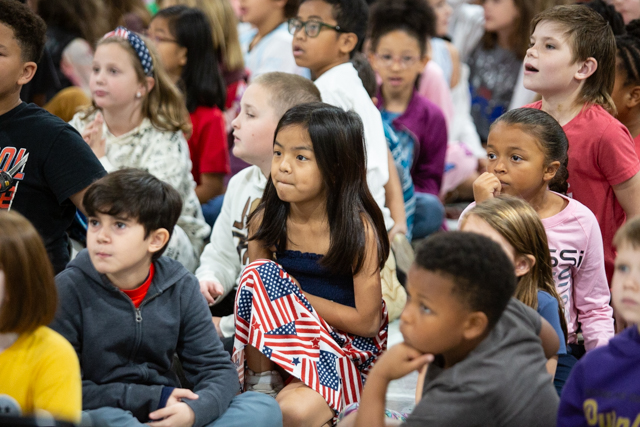Schools blindsided by federal funding freeze
Published 7:00 am Sunday, July 13, 2025
DAVID MAMARIL HOROWITZ
david.horowitz@bgdailynews.com
Staffing, numerous programs at risk after surprise halt
The southcentral Kentucky region’s school districts had anticipated receiving federal funds they had budgeted for in spring. Monies were congressionally approved, and signed off by President Donald Trump in March.
But on June 30, the U.S. Education Department suddenly froze funding across five grant programs totaling more than $6 billion nationwide, stating they were pending review – including about $87 million statewide, according to the Kentucky Department of Education.
These covered $20.3 million for student support and academic enrichment, $33.6 million for supporting effective instruction, $7.9 million for migrant education and $5.7 million for English language acquisition statewide, according to KDE.
KDE hasn’t received grant allocations for the programs under review, so district allocations can’t be calculated. Without federal appropriations, KDE can’t provide 2025-26 allocations for programs, it stated.
The freeze would also eventually apply to funds for 21st Century Community Learning Centers, for which KDE anticipates about $19.4 million in federal funds statewide this year – centers serving students during non-school hours. KDE confirmed that the this funding has been guaranteed for school year 2025-26 but not 2026-27.
Trending
A spokesperson for the federal Office of Management and Budget stated “it’s incorrect to call it a freeze,” calling it “an ongoing programmatic review of education funding.”
“Initial findings,” he stated, “show that many of these grant programs have been grossly misused to subsidize a radical leftwing agenda.”
The spokesperson wrote that New York public schools used funds to “promote illegal immigrant advocacy organizations,” while Washington state used funds to “direct illegal immigrants towards scholarships intended for American students.” School improvement monies elsewhere, he added, had funded “a seminar on ‘queer resistance in the arts.’ ”
Concerning the “programming review,” he added that “no decisions have been made yet.”
Nonetheless, keeping the funds frozen under review risks trimming or otherwise removing important, and sometimes critical, student supports.
Superintendents regionwide described being caught off guard – as their budgets had been carefully designed, with staffing commitments already made.
If the freeze continues this coming school year, some will be forced to strain tight budgets and contingency funds to cover the monies. And if it extends through around April, when school budgets are finalized, it would also put staffing, programs and other expenditures at risk for the 2026-27 school year, superintendents said.
There are also districts without the funding needed to cover the frozen monies for this coming school year. They described a risk that, should funding remain frozen, important and even critical supports will be removed in the 2025-26 year.
Caverna
The grants fund critical programs for children at Caverna Independent School District – and the freeze threatens to postpone or eliminate them, according to CISD Superintendent Amanda Abell.
The freeze covers about $100,000: a little more than half for student support and academic enrichment, and the remainder to professional development, Abell said.
The district would be unable to completely fund the programs over this school year, she said. Unless restored, the freeze will prevent CISD from offering its summer Saturday camp for Science, Technology, Engineering, Arts and Math. It may also prevent CISD from offering its summer school program.
CISD is seeking alternative funding solutions, particularly for supplies serving career and technical education as well as performing arts. However, if the freeze continues, it will necessitate cutting programs in fall intended to prevent drug abuse, bullying, alcohol usage and vaping, according to Abell.
A continued freeze would also require the district to remove a program for girls that surrounds self-esteem, positive body image, and growth mindset, Abell said. And, it would significantly cut support for the district’s career and technical program in 2025-26.
If they’re restored, CISD could potentially launch the programs mid-year – but if not, the district won’t have them, she said.
She pointed to children’s needs surrounding mental health and poverty across Caverna.
“They’re critical programs for our students that became very successful,” Abell said.
Bowling Green
For Bowling Green Independent School District, the freeze holds about $485,400 for this year, equivalent to $408,400 in General Fund spending when accounting for fringe benefits, BGISD Superintendent Gary Fields said.
The district plans to squeeze its tight budget and contingency funds to cover the frozen monies, Fields said.
While some costs can be postponed, others – such as for staff – cannot, given that people are contracted through June 30, 2026, he said.
And if the funds remain frozen through budgeting around April, BGISD would need to make significant cuts to some combination of programs and services in the 2026-27 school year, Fields confirmed.
If the funds remain frozen, the General Fund would pay $107,000 toward English learning, $118,600 for student achievement and $182,800 to support educators and professional development. The freeze would have targeted $274,000 in federal funding for migrant kids too, but BGISD previously removed that program’s funding in anticipation of possible federal cuts.
“If this becomes the norm, what it does is it says, ‘At the end of every school year, in May, we eliminate all the people that are paid by grants, and say, ‘As of right now, you don’t have a contract for next year, and we won’t know if you have a contract until we get our grant funding,’ ” Fields said.
Among such staff would be those who cannot wait until July to get a job – and would seek employment elsewhere, he said.
“It’s just not a way to run a business – people can’t have their lives run like that,” he said.
Warren County
At Warren County Public Schools, the freeze potentially threatens funding that supports some 250 at-risk students who continually move place to place, according to that program’s coordinator, Heather Centers, and WCPS Chief Finance Officer Chris McIntyre.
The program serves students who frequently move due to their families relocating for work in agriculture – movement often causing these students to miss learning opportunities, she said.
The program, which would be significantly impacted by the freeze, supports these students in closing academic gaps, Centers said.
Paraprofessionals, for example, deliver essential services to these students and families. But they’ll lose access to in-home summer tutoring by certified teachers at this month’s end, McIntyre and Centers said.
While the freeze doesn’t directly remove that tutoring program, it has effectively resulted in this discontinuation, McIntyre confirmed.
That is because McIntyre had, in April, previously predicted funding might be halted, and removed from the 2025-26 budget the normally budgeted federal funding across the four pots of currently frozen monies. This was $369,000 in English language acquisition, $751,000 in professional development, $476,041 in student support and academic enrichment funds, and $578,544 in the funding for the students on the move, he said.
Because funds for the frozen monies were already eliminated, that meant no money remained to be frozen. However, there’s still the consequence that WCPS is prepared to return funding to those areas should it become available – and the freeze indicates that those funds, while it’s in effect, will remain halted, McIntyre confirmed.
Summer programming aside, the 2026-27 school year is most at risk for Centers’ program if funding remains halted.
For this fall, there’s at least some relief: McIntyre said he had saved funds last school year to prepare for potential federal funding halts – which WCPS is using to offer those programs at approximately 40% of the normal funding.
That will dry up by the school year’s end. If frozen funding isn’t restored by around April, it would risk WCPS needing to cut them for the 2026-27 school year, he confirmed.
Barren County
At Barren County Schools, at least nine full staffing positions, plus a few part-time positions and extra-duty stipends, get funded by about $1.2 million in federal grants that are pending review, BCS Director of Finance Joe Murley said.
The nearest, most significant potential impact could concern kids who benefit from the district’s regional migrant support program, according to Murley. Barren County serves as the fiscal agent for this program, where its staff additionally serves other school districts. The frozen funds also pay staff who serve BCS students, he added.
While BCS strives to support every child it can, the district has a duty to support Barren County students, Murley said. As a result, the regional migrant program, which anticipates new funding by Oct. 1, would be at risk if the funds remain held, he said.
“They do great work with many different areas around this region – great,” he said. “I’d hate for us to have to impact the program.”
He expressed concern over the lack of notice and the uncertainty surrounding the freeze. The mid-year timing left BCS largely unable to make staffing adjustments due to legal and operational constraints of the school calendar, he said.
If funds remain frozen through budgeting around April, then – like other districts – that could necessitate additional cuts in 2026-27, he confirmed.
Finally, the district gets $690,000 in 21st Century Community Learning Center funding, for serving students during non-school hours. If held for school year 2026-27, it would have a massive impact, he said.
Butler County
The freeze holds $250,000 from Butler County Schools – a significant financial impact for a school system its size, district Superintendent Robert Tuck said.
If the freeze continues, the operating budget and contingency funds would absorb it, he said. But while the district would work to shield classrooms from direct cuts, a continued freeze would likely force the district to delay or scale back planned projects this school year, Tuck said.
Such projects, he said, include instructional upgrades, professional development and expanded student supports. For example, the district normally purchases two buses in October it might need to forgo if the freeze continues, while some construction may also get pushed back, he said.
Secondly, an extended freeze would leave the district potentially needing to postpone updates such as those for Chromebooks, Tuck said.
It could, he said, also potentially lead to cuts in classroom materials as well as staffing that supports students who require additional interventions through Kentucky’s multi-level interventions system.
And, using the General Fund to absorb the frozen monies “could ripple into budget decisions for fiscal year 2026-2027,” he confirmed.
“Even when positions or programs remain intact, reduced funding can slow progress, limit innovation, and restrict our flexibility to meet emerging needs,” he said. “Our goal is always to make thoughtful, strategic decisions – but the impact of a freeze at this level would still be felt.”
Logan County
The most significant impact at Logan County Schools, where frozen funds total more than $337,000, is the timing, according to LCS.
“The federal government withheld this information until the last possible moment, making it extremely difficult to make proactive adjustments, particularly in staffing, based on the availability of these funds,” LCS Director of Federal Programs Nicole Clark stated.
Historically, LCS has allocated approximately $100,000 from the funds to support salaries. If frozen funds remain unavailable, LCS would be forced to rely on its General Fund to cover those expenses, she said.
This, she added, would strain limited resources – potentially affecting other areas of operation.
“As of now, we are approaching the situation with measured patience and are not entering into a state of alarm regarding this year’s (federal grant) funding,” she stated.
The frozen money encompasses $107,219 for migrant education, $150,526 primarily for professional development, $80,454 for staff salaries, school safety initiatives and technology training, and $21,000 for each consortium supporting classroom programs and curriculum for English learners.
“When federal funding is delayed or uncertain, it forces districts to adopt more conservative and inflexible hiring practices than in previous years,” Clark stated, echoing Fields’ point on the importance of timing in retaining qualified staff.







